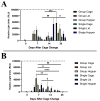Validation of Sanitization Practices in Single-use Individually Ventilated Mouse Cages at Standard and Thermoneutral Temperatures
- PMID: 35840319
- PMCID: PMC9674016
- DOI: 10.30802/AALAS-JAALAS-22-000036
Validation of Sanitization Practices in Single-use Individually Ventilated Mouse Cages at Standard and Thermoneutral Temperatures
Abstract
Vivarium husbandry practices are based on performance data and adhere to applicable regulatory guidelines. Refinements in husbandry and optimization of sanitization protocols improve animal wellbeing and help standardize the microenvironment, contributing to research reproducibility. The objective of this study was to evaluate the microenvironment to establish performance standards for mouse husbandry and sanitization, including housing at standard and thermoneutral temperatures. Male C57BL/6J mice were housed singly and in groups in disposable IVCs on α-cellulose or corncob bedding and microenvironmental indicators (ammonia, carbon dioxide) were evaluated. In addition, microbial bioburden tests (ATP and RODAC) were performed on cages and cage accessories on days 0, 7, 14 and, 28 to 30 after cage change. Water testing and aerobic culture of the waterspout of bottles containing chlorinated water were performed to determine acceptable replacement schedules. Ammonia levels remained below the National Institute of Occupational Safety and Health 8-h recommended exposure limit for humans (25 ppm) at all time points for all housing conditions through day 21 for group-housed mice, and through day 30 for singly housed mice. Microbial bioburden results for cage accessories and water testing were acceptable up to 28 d after cage change (RODAC less than 50 CFU; ATP less than 100,000 RLU) at both standard and thermoneutral housing temperatures. Mice remained clinically healthy throughout the studies. These results support site operating practices and verify extended sanitization recommendations per the Guide of the Care and Use of Laboratory Animals in this disposable IVC environment: group-housed mice receive bottom cage and water bottle change up to every 14 d with full cage change (including lid and accessories) every 28 d, and singly housed mice receive full cage change every 28 to 30 d or sooner.
Figures




Similar articles
-
Carbon Dioxide, Oxygen, and Ammonia Levels in Mouse and Rat Disposable IVC Removed from Mechanical Ventilation.J Am Assoc Lab Anim Sci. 2022 Sep 1;61(5):432-440. doi: 10.30802/AALAS-JAALAS-22-000028. Epub 2022 Aug 31. J Am Assoc Lab Anim Sci. 2022. PMID: 36045005 Free PMC article.
-
Effect of 2 Bedding Materials on Ammonia Levels in Individually Ventilated Cages.J Am Assoc Lab Anim Sci. 2016 Jan;55(1):25-8. J Am Assoc Lab Anim Sci. 2016. PMID: 26817976 Free PMC article.
-
Cage change intervals for opossums (Monodelphis domestica) in individually ventilated cages.J Am Assoc Lab Anim Sci. 2011 Sep;50(5):647-52. J Am Assoc Lab Anim Sci. 2011. PMID: 22330710 Free PMC article.
-
Ammonia Measurement in the IVC Microenvironment.J Am Assoc Lab Anim Sci. 2019 Mar 1;58(2):184-189. doi: 10.30802/AALAS-JAALAS-18-000006. Epub 2019 Jan 31. J Am Assoc Lab Anim Sci. 2019. PMID: 30704550 Free PMC article. Review.
-
A Review of the Effects of Some Extrinsic Factors on Mice Used in Research.Comp Med. 2023 Dec 1;73(6):413-431. doi: 10.30802/AALAS-CM-23-000028. Comp Med. 2023. PMID: 38217072 Free PMC article. Review.
References
-
- Clifford CB, Pritchett-Corning KR. 2012. The Laboratory Mouse (Second Edition). Cambridge (MA): Academic Press.
-
- Ednie DL, Wilson RP, Lang CM. 1998. Comparison of two sanitation monitoring methods in an animal research facility. Contemp Top Lab Anim Sci 37:71–74. - PubMed
MeSH terms
Substances
LinkOut - more resources
Full Text Sources

